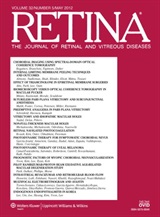In questo lavoro i ricercatori hanno misurato l’effetto dell’iniezione intravitreale di Avastin sull’emodinamica oculare mediante l’ultrasonografia color Doppler. È stata confrontata l’emodinamica dell’occhio che riceveva l’iniezione e dell’occhio adelfo.
È risultata un effetto significativo sull’emodinamica oculare con riduzione della velocità sistolica di picco ed aumento degli indici di resistenza a carico dell’arteria centrale della retina e delle arterie ciliari posteriori brevi. Anche nell’occhio controlaterale si è registrata una riduzione della velocità sistolica di picco ma non un aumento delle resistenze.
Questi dati sono importanti per comprendere l’effetto bilaterale della singola iniezione e valutare con maggiore prudenza la condizione di occhi con preesistenti difficoltà di perfusione.
Hosseini, Hamid MD*; Lotfi, Mehrzad MD†; Esfahani, Mina Heidari MD†; Nassiri, Nariman MD‡; Khalili, Mohammad Reza MD*; Razeghinejad, Mohammad Reza MD*; Nouri-Mahdavi, Kouros MD, Msc§
Retina
May 2012 – Volume 32 – Issue 5
Background: To determine the effect of intravitreal administration of bevacizumab (1.25 mg/0.05 mL) on retrobulbar circulation of the injected and the fellow (uninjected) eyes in patients with neovascular age-related macular degeneration.
Methods: In this prospective study, the retrobulbar hemodynamics of 43 patients with neovascular age-related macular degeneration was examined by color Doppler ultrasonography. Peak systolic velocity, end-diastolic velocity, and resistive index values in the central retinal artery and short posterior ciliary artery in both injected and uninjected fellow eyes were measured at baseline and 7 days after a single intravitreal injection of bevacizumab.
Results: At baseline, the peak systolic velocity, end-diastolic velocity, and the resistive index in the central retinal artery and short posterior ciliary artery of the injected eye were not significantly different compared with the fellow uninjected eye (P > 0.05 for all). However, intravitreal bevacizumab induced a significant reduction in the peak systolic velocity and end-diastolic velocity and a significant rise in the resistive index of the central retinal artery and short posterior ciliary artery of the injected eyeP ≤ 0.006 for all). Peak systolic velocity and end-diastolic velocity decreased in the central retinal artery (P = 0.023 and P = 0.030) and the short posterior ciliary artery (P = 0.001 and P < 0.000) in the uninjected eye while the resistive index did not significantly change in central retinal artery (P = 0.114) and short posterior ciliary artery (P = 0.082) of the fellow eyes. Conclusion: Intravitreal injection of bevacizumab significantly affects ocular hemodynamic parameters of both the injected and the uninjected fellow eyes with neovascular age-related macular degeneration.
Conclusion: Intravitreal injection of bevacizumab significantly affects ocular hemodynamic parameters of both the injected and the uninjected fellow eyes with neovascular age-related macular degeneration.

 Effect of Intravitreal Bevacizumab on Retrobulbar Blood Flow in Injected and Uninjected Fellow Eyes of Patients With Neovascular Age-Related Macular Degeneration
Effect of Intravitreal Bevacizumab on Retrobulbar Blood Flow in Injected and Uninjected Fellow Eyes of Patients With Neovascular Age-Related Macular Degeneration